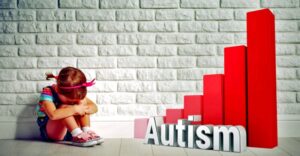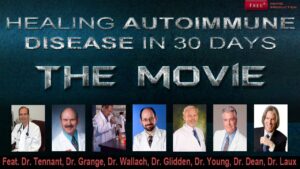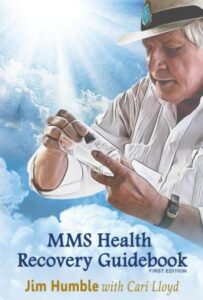1 in 36 Kids Have Autism, CDC Says — Critics Slam Agency’s Failure to Investigate Causes
One in 36 (2.8%) 8-year-old children — 4% of boys and 1% of girls — have an autism spectrum disorder (ASD), based on an analysis of data from 2020, published today by the Centers for Disease Control and Prevention. One in 36 (2.8%) 8-year-old children — 4% of boys and 1% of girls — have an autism spectrum disorder (ASD), based on an analysis of data from 2020, published today by the Centers for Disease Control and Prevention (CDC). Autism Affects 1 in 36 Kids States CDC
The latest findings, reported in the CDC’s Morbidity and Mortality Weekly Report, show an increase from the last report, which found 1 in 44 8-year-olds (2.3%) had autism in 2018.
Since the CDC started collecting the data, prevalence estimates have skyrocketed from 1 in 150 in 2000, to today’s estimate of 1 in 36 children.
The trend has persisted for decades. Autism prevalence in the 1990s, which was 1 in 1,000 children, already represented a tenfold increase over the condition’s estimated prevalence in the 1970s.
Commenting on today’s report, Mark Blaxill, from the Executive Leadership Team at Health Choice, told The Defender: “As the American culture wars have intensified, the harsh reality of the autism epidemic has been tucked away into obscurity as attention has turned to a whole new set of health concerns.
“Today’s new report from the CDC’s ADDM [Autism and Developmental Disabilities Monitoring] Network places the latest ASD rate at 1 in 36 children born in 2012, but that’s not even the largest number out there (a recent survey using NHIS data reported a rate of 1 in 29 children in 2020).”
A second CDC report on 4-year-old children, also released today, emphasized that in the early months of the COVID-19 pandemic, 4-year-old children were less likely to be evaluated for or identified with ASD than 8-year-olds of the same age.
Prior to the pandemic, 4-year-old children were diagnosed with autism at even higher rates than the 8-year-old cohort.
For the first time since the CDC began doing these studies, both studies found autism prevalence was higher among Black, Hispanic and Asian/Pacific Islander children than among White and biracial children. ASD prevalence among these groups increased 30% between 2018 and 2020.
The prevalence report suggested these numbers “might reflect improved screening, awareness, and access to services among historically underserved groups.”
Commenting on the CDC’s assertion that children of color have higher rates of autism than white children because of improved screening and awareness, Sallie Bernard, co-founder and board president of SafeMinds, told The Defender: “That does not explain why their rate is higher than white children. As a group, no racial or ethnic minority here gets better assessment and diagnosis than white children, so to explain the disparity in the rate now as due to better assessment for minorities is just ludicrous.”
Conclusory statements attributing growth in autism numbers to “more awareness and a wider ability of services” is part of a long-term trend among public health officials and the media.
Most autistic children were found to either have an intellectual disability (37.9%) or to be on the borderline for having one (23.5%).
Black children with autism were far more likely than white children to have a co-occurring intellectual disability, which the report said might stem from “underascertainment of ASD among Black children without intellectual disability.”
The recommendation for “public health action” is to develop “enhanced infrastructure to provide equitable diagnostic, treatment, and support services for all children with ASD.”
Bernard agreed that there is a need for greater infrastructure and support. “The services and supports have been lacking forever. And now if you have a four-fold increase [in ASD], it is going to be four times worse,” she said.
She added: “Now they’ve diagnosed that Black children have such a high rate of intellectual disability and borderline intellectual disability. That’s a group of people with autism that have the toughest time in life. For families, it’s so hard. And so they absolutely need more attention.
“But it doesn’t explain the social determinants of health. For that, we need environmental justice. You have to ask what are they exposed to?”
But the report makes no comment on the causes of autism, nor does it offer an explanation for the rising rates beyond increased testing.
The Defender asked Bernard whether she thought better testing could be driving the trends. She said: “There’s been this implication that what’s driving the rates is the [ASD diagnosis] of the lower support needs individuals, that we used to call Asperger’s. Or that perhaps it is the folks who were really really impacted and have very profound intellectual disability that’s driving the trends. Or, now, that there is better detection among racial and ethnic minorities that have been marginalized.
“But when you look at the trends, no matter how you break it down, autism is rising in all of these groups and it has been since they started taking the data 20 years ago.
“It’s hard to believe that when the experts went out and did their epidemiology studies and found lower rates in the past that they would have missed out on 3 of 4 kids on the spectrum.”
Toby Rogers, Ph.D., had this to say about the CDC’s claims that better testing is behind the growing number of autism cases:
“The unwillingness of the CDC to even ask why these numbers are increasing is a massive ‘poker tell’ that they know but are prohibited from talking about it.
“Two high-quality, multi-million dollar studies in California (Byrd et al., 2002; Hertz-Picciotto and Delwiche, 2009) both concluded that better awareness, changes in diagnostic criteria and earlier age of diagnosis only explain a small fraction of the rise in autism.
“The authors of these studies urged public health officials to place greater emphasis on researching the toxicants that might be driving the increase in autism prevalence. [For a longer discussion of these studies please see Rogers, 2019.] The fact that the CDC is still refusing to properly investigate autism causation is outrageous.”
Bernard said we need to search for other explanations for this increase.
“There are many studies suggesting that something in our environment is driving the increase in autism, and that’s where we need to focus our attention,” she said.
As autism rates skyrocketed among U.S. children over the past several decades, along with concern among parents, much research has turned to investigate the role of environmental risk factors in compounding underlying diverse genetic factors.
Environmental risk factors include metals like aluminum and mercury in vaccines, glyphosate exposure, use of acetaminophen during pregnancy and infancy, heavy metals in baby food and other organic environmental pollutants.
Studies also link industrial chemicals, such as lead, arsenic, copper, selenium, iron and magnesium, to the disorder.
Despite growing evidence that environmental factors may play a role in the development of ASD, the CDC did not investigate environmental exposures as a potential cause.
According to Blaxill: “No one asks the obvious questions: Why are so many children sick? What is this all going to cost? Who will take care of these children when their parents are gone?
“And of course there are the related questions: What are these people thinking and how do they go to sleep at night? I wish I knew.”
Higher rates of autism: ‘encouraging patterns?’
The ADDM study on prevalence among 8-year-olds is the CDC’s standard for estimating autism rates. It uses the ADDM Network to estimate the number of children with ASD and other developmental disabilities living in different areas of the U.S.
The CDC established the ADDM Network in 2000. It tracks rates of autism in 8-year-old children by analyzing education, medical and service provider records. It releases reports every two years.
The first ADDM Network site was in Georgia. The study released today includes research sites in Arizona, Arkansas, California, Georgia, Maryland, Minnesota, Missouri, New Jersey, Tennessee, Utah and Wisconsin.
The report found autism prevalence rates vary widely geographically, with the lowest rates in Maryland and the highest rates in California.
The early ADDM Report analyzes autism diagnoses for 4-year-old children among the same network sites. It reported that rates also varied substantially by location, and attributed higher rates of autism diagnoses among 4-year-olds than 8-year-olds to higher diagnosis rates.
According to the report:
“From 2016 through 2020, children aged 4 years mostly had a pattern of more evaluations and identifications than the cohort aged 8 years had from 2012 through 2016, until the pandemic onset in March of 2020 when the pattern reversed. …
“In 2020, higher cumulative incidence of ASD by age 48 months among children aged 4 years compared with children aged 8 years was seen at all sites, indicating improvements in early identification of ASD.”
The report emphasized that COVID-19 pandemic measures disrupted evaluations and treatments and recommended “public health action” include communities evaluating the impact of disruptions to services due to public health emergencies more generally.
The authors called the consistent increases in diagnoses among 4-year-olds over the past several years “encouraging patterns,” because they said they indicated better diagnosis.
The major concern raised in this report was that during the pandemic, these numbers dropped.
Big Pharma has its eye on rising autism rates in the U.S. and across the world. A series of reports published over the last 12 months predicted massive growth in the ASD treatment industry over the next several years due to rising global rates of autism and increasing investment in pharmaceutical research and development.
Commenting on the regulatory and other failures that brought autism rates to this point, Rogers told The Defender:
“The CDC, FDA and NIH have all failed. Their leadership should be sacked, arrested and prosecuted for crimes against humanity.
“We absolutely know how to stop the autism epidemic — keep toxic substances out of kids’ bodies. Toxic substances known to increase the risk of developing autism include mercury, ingredients in plastics and fire retardants, pesticides and herbicides, EMF/RFR, and pharmaceuticals (Tylenol, SSRIs and vaccines).
“Autism is not a scientific mystery. The autism epidemic is largely the result of bad laws, regulatory capture, and the CDC childhood vaccine schedule.” Ref:
Miss a day, miss a lot. Subscribe to The Defender’s Top News of the Day. It’s free.
Comments: I would start with eliminating the childhood vaccine schedule completely and see if autism continues to climb, or do a blind RCT Randomized Control Test) giving some newborns the vaccines and another group of newborns no vaccines and no additives in the placebo like many of the original vaccine “tests”. I am a proponent that vaccines are the cause of many of the illnesses and especially ASD. If your child has been subject to the onslaught of vaccines since birth and is functioning normally congratulations. There are many who have not been as lucky. According to some high level sources there are over 31 million people who are on the autism spectrum. And it isn’t genetic, as some have espoused. If that were the case then parents and grandparents would be on the spectrum as well. The childhood vaccine schedule is an attack of our most vulnerable, the kids. The Childhood Vaccine Schedule is a ruse and a money maker for the Big Pharma.
————————————————————————————————————————————————————————————————————————————
———————————————————————————————————————————————————————————————————————————
———————————————————————————————————————————————————————————————————————————-
————————————————————————————————————————————————————————————————————————————-






